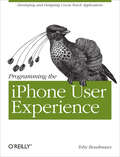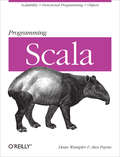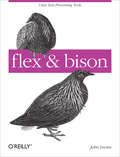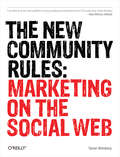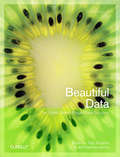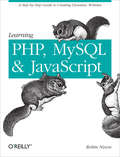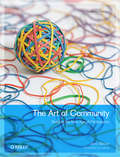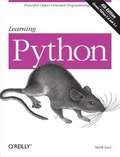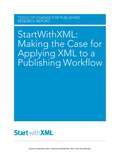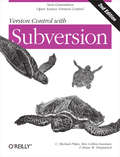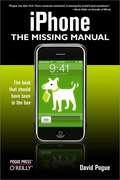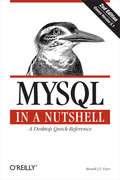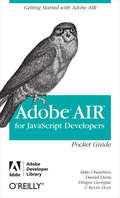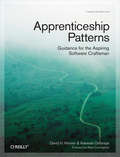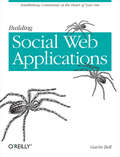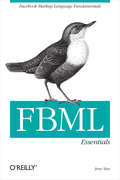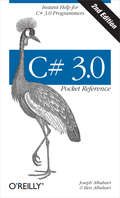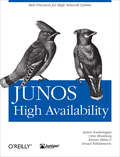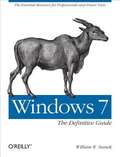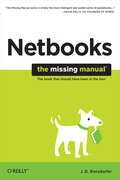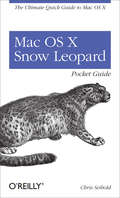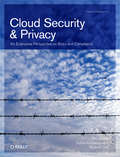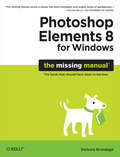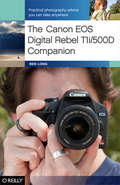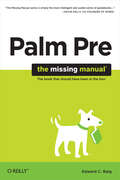- Table View
- List View
Programming the iPhone User Experience: Developing and Designing Cocoa Touch Applications
by Toby BoudreauxApple's iPhone and iPod Touch not only feature the world's most powerful mobile operating system, they also usher in a new standard of human-computer interaction through gestural interfaces and multi-touch navigation. This book provides you with a hands-on, example-driven tour of UIKit, Apple's user interface toolkit, and includes common design patterns to help you create new iPhone and iPod Touch user experiences. Using Apple's Cocoa Touch framework, you'll learn how to build applications that respond in unique ways when users tap, slide, swipe, tilt, shake, or pinch the screen. Programming the iPhone User Experience is a perfect companion to Apple's Human Interface Guidelines, and provides the practical information you need to develop innovative applications for the iPhone and iPod Touch, whether you're a CTO, developer, or UI/UX designer.Understand the basics of the Cocoa Touch framework for building iPhone and iPod Touch applications Learn theory and best practices for using Cocoa Touch to develop applications with engaging and effective user interfaces Apply your knowledge of Objective-C to the iPhone/iPod Touch framework Customize standard UIKit views according to Apple's Human Interface Guidelines and usability principles Learn patterns for handling user experience concerns outside of the interface, such as network- and location-awareness
Programming Scala: Scalability = Functional Programming + Objects (Animal Guide)
by Dean Wampler Alex PayneLearn how to be more productive with Scala, a new multi-paradigm language for the Java Virtual Machine (JVM) that integrates features of both object-oriented and functional programming. With this book, you'll discover why Scala is ideal for highly scalable, component-based applications that support concurrency and distribution. Programming Scala clearly explains the advantages of Scala as a JVM language. You'll learn how to leverage the wealth of Java class libraries to meet the practical needs of enterprise and Internet projects more easily. Packed with code examples, this book provides useful information on Scala's command-line tools, third-party tools, libraries, and available language-aware plugins for editors and IDEs.Learn how Scala's succinct and flexible code helps you program fasterDiscover the notable improvements Scala offers over Java's object modelGet a concise overview of functional programming, and learn how Scala's support for it offers a better approach to concurrencyKnow how to use mixin composition with traits, pattern matching, concurrency with Actors, and other essential featuresTake advantage of Scala's built-in support for XMLLearn how to develop domain-specific languagesUnderstand the basics for designing test-driven Scala applications
flex & bison: Text Processing Tools
by John LevineIf you need to parse or process text data in Linux or Unix, this useful book explains how to use flex and bison to solve your problems quickly. flex & bison is the long-awaited sequel to the classic O'Reilly book, lex & yacc. In the nearly two decades since the original book was published, the flex and bison utilities have proven to be more reliable and more powerful than the original Unix tools. flex & bison covers the same core functionality vital to Linux and Unix program development, along with several important new topics. You'll find revised tutorials for novices and references for advanced users, as well as an explanation of each utility's basic usage and simple, standalone applications you can create with them. With flex & bison, you'll discover the wide range of uses these flexible tools offer.Address syntax crunching that regular expressions tools can't handleBuild compilers and interpreters, and handle a wide range of text processing functionsInterpret code, configuration files, or any other structured formatLearn key programming techniques, including abstract syntax trees and symbol tablesImplement a full SQL grammar-with complete sample codeUse new features such as pure (reentrant) lexers and parsers, powerful GLR parsers, and interfaces to C++
The New Community Rules: Marketing on the Social Web
by Tamar WeinbergBlogs, networking sites, and other examples of the social web provide businesses with a largely untapped marketing channel for products and services. But how do you take advantage of them? With The New Community Rules, you'll understand how social web technologies work, and learn the most practical and effective ways to reach people who frequent these sites. Written by an expert in social media and viral marketing, this book cuts through the hype and jargon to give you intelligent advice and strategies for positioning your business on the social web, with case studies that show how other companies have used this approach. The New Community Rules will help you:Explore blogging and microblogging, and find out how to use applications such as Twitter to create brand awarenessLearn the art of conversation marketing, and how social media thrives on honesty and transparencyManage and enhance your online reputation through the social webTap into the increasingly influential video and podcasting marketDiscover which tactics work -- and which don't -- by learning about what other marketers have triedMany consumers today use the Web as a voice. The New Community Rules demonstrates how you can join the conversation, contribute to the community, and bring people to your product or service.
Beautiful Data: The Stories Behind Elegant Data Solutions
by Toby Segaran Jeff HammerbacherIn this insightful book, you'll learn from the best data practitioners in the field just how wide-ranging -- and beautiful -- working with data can be. Join 39 contributors as they explain how they developed simple and elegant solutions on projects ranging from the Mars lander to a Radiohead video.With Beautiful Data, you will:Explore the opportunities and challenges involved in working with the vast number of datasets made available by the WebLearn how to visualize trends in urban crime, using maps and data mashupsDiscover the challenges of designing a data processing system that works within the constraints of space travelLearn how crowdsourcing and transparency have combined to advance the state of drug researchUnderstand how new data can automatically trigger alerts when it matches or overlaps pre-existing dataLearn about the massive infrastructure required to create, capture, and process DNA dataThat's only small sample of what you'll find in Beautiful Data. For anyone who handles data, this is a truly fascinating book. Contributors include:Nathan YauJonathan Follett and Matt HolmJ.M. HughesRaghu Ramakrishnan, Brian Cooper, and Utkarsh SrivastavaJeff HammerbacherJason Dykes and Jo WoodJeff Jonas and Lisa SokolJud ValeskiAlon Halevy and Jayant MadhavanAaron Koblin with Valdean KlumpMichal MigurskiJeff HeerCoco KrummePeter NorvigMatt Wood and Ben BlackburneJean-Claude Bradley, Rajarshi Guha, Andrew Lang, Pierre Lindenbaum, Cameron Neylon, Antony Williams, and Egon WillighagenLukas Biewald and Brendan O'ConnorHadley Wickham, Deborah Swayne, and David PooleAndrew Gelman, Jonathan P. Kastellec, and Yair GhitzaToby Segaran
Learning PHP, MySQL, and JavaScript: A Step-By-Step Guide to Creating Dynamic Websites (Animal Guide)
by Robin NixonIf you know HTML, this guide will have you building interactive websites quickly. You'll learn how to create responsive, data-driven websites with PHP, MySQL, and JavaScript, regardless of whether you already know how to program. Discover how the powerful combination of PHP and MySQL provides an easy way to build modern websites complete with dynamic data and user interaction. You'll also learn how to add JavaScript to create rich Internet applications and websites.Learning PHP, MySQL, and JavaScript explains each technology separately, shows you how to combine them, and introduces valuable web programming concepts, including objects, XHTML, cookies, and session management. You'll practice what you've learned with review questions in each chapter, and find a sample social networking platform built with the elements introduced in this book. This book will help you:Understand PHP essentials and the basics of object-oriented programming Master MySQL, from database structure to complex queries Create web pages with PHP and MySQL by integrating forms and other HTML features Learn about JavaScript, from functions and event handling to accessing the Document Object Model Use libraries and packages, including the Smarty web template system, PEAR program repository, and the Yahoo! User Interface LibraryMake Ajax calls and turn your website into a highly dynamic environment Upload and manipulate files and images, validate user input, and secure your applications
The Art of Community: Building the New Age of Participation (Theory in Practice)
by Jono BaconOnline communities offer a wide range of opportunities today, whether you're supporting a cause, marketing a product or service, or developing open source software. The Art of Community will help you develop the broad range of talents you need to recruit members to your community, motivate and manage them, and help them become active participants. Author Jono Bacon offers a collection of experiences and observations from his decade-long involvement in building and managing communities, including his current position as manager for Ubuntu, arguably the largest community in open source software. You'll discover how a vibrant community can provide you with a reliable support network, a valuable source of new ideas, and a powerful marketing force.The Art of Community will help you:Develop a strategy, with specific objectives and goals, for building your communityBuild simple, non-bureaucratic processes to help your community perform tasks, work together, and share successesProvide tools and infrastructure that let contributors work quicklyCreate buzz around your community to get more people involvedTrack the community's work so it can be optimized and simplifiedExplore a capable, representative governance strategy for your communityIdentify and manage conflict, including dealing with divisive personalities
Learning Python, 4th Edition
by Mark LutzGoogle and YouTube use Python because it's highly adaptable, easy to maintain, and allows for rapid development. If you want to write high-quality, efficient code that's easily integrated with other languages and tools, this hands-on book will help you be productive with Python quickly -- whether you're new to programming or just new to Python. It's an easy-to-follow self-paced tutorial, based on author and Python expert Mark Lutz's popular training course. Each chapter contains a stand-alone lesson on a key component of the language, and includes a unique Test Your Knowledge section with practical exercises and quizzes, so you can practice new skills and test your understanding as you go. You'll find lots of annotated examples and illustrations to help you get started with Python 3.0. Learn about Python's major built-in object types, such as numbers, lists, and dictionaries Create and process objects using Python statements, and learn Python's general syntax model Structure and reuse code using functions, Python's basic procedural tool Learn about Python modules: packages of statements, functions, and other tools, organized into larger components Discover Python's object-oriented programming tool for structuring code Learn about the exception-handling model, and development tools for writing larger programs Explore advanced Python tools including decorators, descriptors, metaclasses, and Unicode processing
StartWithXML: Making the Case for Applying XML to a Publishing Workflow
by Mike Shatzkin Brian O'Leary Laura Dawson Ted HillPublishers face a "Copernican change." Until recently, the book was"the sun" of a publishing solar system, and all other opportunitieswere subsidiary rights revolving as planets around it. Now, theintellectual property is the sun, and the book becomes just one of theorbiting opportunities. To be successful in the 21st centuryenvironment, publishers must produce agile content: content that canbe rendered in different forms without great additional expense. XMLprovides both a path to agility and opens opportunities for currentand future digital content revenue streams. StartWithXML is an industry-wide project to understand and spread theknowledge publishers need to move forward with XML. It's about thebusiness issues driving the "why" of XML and the technical andorganizational issues, strategies, and tactics underlying the "how" ofgetting started. This research report takes a pragmatic look at XMLworkflows, addressing questions such as:Where am I and where do I want to end up?How much benefit do I want to obtain from content reuse and repurposing?How much work do I want to do myself?How much time and money will this take?What can I do internally to increase my chances of success?
Version Control with Subversion: Next Generation Open Source Version Control
by Ben Collins-Sussman Brian W. Fitzpatrick C. Michael PilatoWritten by members of the development team that maintains Subversion, this is the official guide and reference manual for the popular open source revision control technology. The new edition covers Subversion 1.5 with a complete introduction and guided tour of its capabilities, along with best practice recommendations.Version Control with Subversion is useful for people from a wide variety of backgrounds, from those with no previous version control experience to experienced system administrators.Subversion is the perfect tool to track individual changes when several people collaborate on documentation or, particularly, software development projects. As a more powerful and flexible successor to the CVS revision control system, Subversion makes life so much simpler, allowing each team member to work separately and then merge source code changes into a single repository that keeps a record of each separate version.Inside the updated edition Version Control with Subversion, you'll find:An introduction to Subversion and basic concepts behind version controlA guided tour of the capabilities and structure of Subversion 1.5Guidelines for installing and configuring Subversion to manage programming, documentation, or any other team-based projectDetailed coverage of complex topics such as branching and repository administrationAdvanced features such as properties, externals, and access controlA guide to best practicesComplete Subversion reference and troubleshooting guideIf you've never used version control, you'll find everything you need to get started. And if you're a seasoned CVS pro, this book will help you make a painless leap into Subversion.
iPhone: The Missing Manual
by David PogueAs you'd expect of Apple, the iPhone is gorgeous. iPhone: The Missing Manual is a book as breathtaking as its subject. Teeming with high-quality color graphics, each custom designed page helps you accomplish specific tasks -- everything from Web browsing to watching videos. Written by New York Times columnist and Missing Manual series creator David Pogue, this book shows you how to get the most out of your new Apple iPhone.The name iPhone may be doing Apple a disservice. This machine is so packed with possibilities that the cellphone may actually be the least interesting part. The iPhone is at least three products merged into one: a phone, a wide-screen iPod and a wireless, touch-screen Internet communicator. The iPhone's beauty alone may be enough for you to dig for your credit cards, but its Mac OS X-based software makes it not so much a smartphone as something out of the film "Minority Report."The real magic, however, awaits when you browse the Web. You get to see the entire Web page on the iPhone's screen. All of this is cooked up with Apple's traditional secret sauce of simplicity, intelligence and whimsy.Written by New York Times columnist and Missing Manual series creator David Pogue, iPhone: The Missing Manual shows you everything they need to know to get the most out of your new Apple iPhone. Full of humor, tips, tricks, and surprises, this book teaches you how to extend iPhone's usefulness by exploiting its links to the Web as well as its connection to Macs or PCs; how to save money using Internet-based messages instead of phone calls; and how to fill the iPhone with TV shows and DVDs for free.
MySQL in a Nutshell: A Desktop Quick Reference (In a Nutshell (O'Reilly))
by Russell J.T. DyerWhen you need to find the right SQL keyword or MySQL client command-line option right away, turn to this convenient reference, known for the same speed and flexibility as the system it covers so thoroughly. MySQL is packed with so many capabilities that the odds of remembering a particular function or statement at the right moment are pretty slim. With MySQL in a Nutshell, you get the details you need, day in and day out, in one concise and extremely well organized book.The new edition contains all the commands and programming information for version 5.1, including new features and language interfaces. It's ideal for anyone using MySQL, from novices who need to get up to speed to advanced users who want a handy reference. Like all O'Reilly Nutshell references, it's easy to use and highly authoritative, written by the editor of the MySQL Knowledge Base at MySQL AB, the creator and owner of MySQL. Inside, you'll find:A thorough reference to MySQL statements, functions, and administrative utilitiesSeveral tutorial chapters to help newcomers get startedProgramming language APIs for PHP, Perl, and CBrief tutorials at the beginning of each API chapter to help anyone, regardless of experience level, understand and master unfamiliar territoryNew chapters on replication, triggers, and stored proceduresPlenty of new examples of how MySQL is used in practiceUseful tips to help you get through the most difficult subjectsWhether you employ MySQL in a mission-critical, heavy-use environment or for applications that are more modest, this book puts a wealth of easy-to-find information at your fingertips, saving you hundreds of hours of trial and error and tedious online searching. If you're ready to take advantage of everything MySQL has to offer, MySQL in a Nutshell has precisely what it takes.
AIR for Javascript Developers Pocket Guide: Getting Started with Adobe AIR (Pocket Guide)
by Mike Chambers Daniel Dura Kevin Hoyt Dragos GeorgitaThis book is the official guide to Adobe ® AIR[TM], written by members of the AIR team. With Adobe AIR, web developers can use technologies like HTML and JavaScript to build and deploy web applications to the desktop. Packed with examples, this book explains how AIR works and features recipes for performing common runtime tasks. Part of the Adobe Developer Library, this concise pocket guide explains:What Adobe AIR is, and the problems this runtime aims to solve How to set up your development environment The HTML and JavaScript environments within AIR How to create your first AIR application using HTML and JavaScript Ways to perform an array of common tasks with this runtimeAlso included is a guide to AIR packages, classes, and command line tools. Once you understand the basics of building HTML- and JavaScript-based AIR applications, this book makes an ideal reference for tackling specific problems. It offers a quick introduction to a significant new development technology, which lets you combine the reach and ease of the Web with the power of the desktop.
Apprenticeship Patterns: Guidance for the Aspiring Software Craftsman
by Dave Hoover Adewale OshineyeAre you doing all you can to further your career as a software developer? With today's rapidly changing and ever-expanding technologies, being successful requires more than technical expertise. To grow professionally, you also need soft skills and effective learning techniques. Honing those skills is what this book is all about. Authors Dave Hoover and Adewale Oshineye have cataloged dozens of behavior patterns to help you perfect essential aspects of your craft.Compiled from years of research, many interviews, and feedback from O'Reilly's online forum, these patterns address difficult situations that programmers, administrators, and DBAs face every day. And it's not just about financial success. Apprenticeship Patterns also approaches software development as a means to personal fulfillment. Discover how this book can help you make the best of both your life and your career. Solutions to some common obstacles that this book explores in-depth include: Burned out at work? "Nurture Your Passion" by finding a pet project to rediscover the joy of problem solving.Feeling overwhelmed by new information? Re-explore familiar territory by building something you've built before, then use "Retreat into Competence" to move forward again.Stuck in your learning? Seek a team of experienced and talented developers with whom you can "Be the Worst" for a while."Brilliant stuff! Reading this book was like being in a time machine that pulled me back to those key learning moments in my career as a professional software developer and, instead of having to learn best practices the hard way, I had a guru sitting on my shoulder guiding me every step towards master craftsmanship. I'll certainly be recommending this book to clients. I wish I had this book 14 years ago!"-Russ Miles, CEO, OpenCredo
Building Social Web Applications: Establishing Community at the Heart of Your Site
by Gavin BellBuilding a web application that attracts and retains regular visitors is tricky enough, but creating a social application that encourages visitors to interact with one another requires careful planning. This book provides practical solutions to the tough questions you'll face when building an effective community site -- one that makes visitors feel like they've found a new home on the Web.If your company is ready to take part in the social web, this book will help you get started. Whether you're creating a new site from scratch or reworking an existing site, Building Social Web Applications helps you choose the tools appropriate for your audience so you can build an infrastructure that will promote interaction and help the community coalesce. You'll also learn about business models for various social web applications, with examples of member-driven, customer-service-driven, and contributor-driven sites. Determine who will be drawn to your site, why they'll stay, and who they'll interact withCreate visual design that clearly communicates how your site worksBuild the software you need versus plugging in one-size-fits-all, off-the-shelf appsManage the identities of your visitors and determine how to support their interactionMonitor demand from the community to guide your choice of new functionsPlan the launch of your site and get the message out
FBML Essentials: Facebook Markup Language Fundamentals
by Jesse StayDo you have an idea for a Facebook application? With FBML Essentials, you'll learn how to build it quickly using the Facebook Markup Language (FBML) and other easy-to-use tools in the site's framework. If you can develop a website with HTML, writing a Facebook application with the help of this book will be a breeze. Of course, Facebook is not just another website. Any applications you write for it will have a potential audience of 16 million dedicated users. It's not just another social networking site, either. Under the surface, Facebook is pretty sophisticated, with a development toolkit that includes it's own modified version of HTML -- FBML -- to customize the look and feel of your Facebook applications. With FBML Essentials, you not only learn how to get started with this toolkit, you also get a complete reference on every FBML tag Facebook has ever written, with examples of how each tag works and advice on the best ways to use these tags in your code. This book includes:A walkthrough of a sample Facebook application Design rules for using images, CSS, JavaScript, and forms Specific chapters on tags -- authorization tags, logic tags, user/group tags, profile-specific tags, and more Messaging and alerts using FBML Creating forms with FBML Facebook navigation Notifications and requests Dynamic FBML attributes, including MockAJAX How to test your FBML code A chapter on FBJS, Facebook's version of JavaScript If you want to try your hand at writing a Facebook application, you have a willing audience, an easy-to-use toolkit, and the perfect guide to get you started. FBML Essentials will help you take your idea from conception to working application in no time.
C# 3.0 Pocket Reference: Instant Help for C# 3.0 Programmers (Pocket Reference (O'Reilly))
by Ben Albahari Joseph AlbahariThis book is for busy programmers who want a succinct and yet readable guide to C# 3.0 and LINQ. C# 3.0 Pocket Reference tells you exactly what you need to know, without long introductions or bloated samples.Despite its conciseness, this book doesn't skimp on depth or detail, and embraces the conceptual challenges in learning C# 3.0 and LINQ. Tightly focused and highly practical, this pocket reference covers more ground than many of the big books on C#.C# 3.0 Pocket Reference includes plenty of illustrations and code examples to explain:Features new to C# 3.0, such as lambda expressions, anonymous types, automatic properties, and moreAll aspects of C# syntax, predefined types, expressions, and operatorsCreating classes, structs, delegates and events, enums, generics and constraints, exception handling, and iteratorsThe subtleties of boxing, operating overloading, delegate covariance, extension method resolution, interface reimplementation, nullable types, and operating liftingLINQ, starting with the principles of sequences, deferred execution and standard query operators, and finishing with a complete reference to query syntax-including multiple generators, joining, grouping, and query continuationsConsuming, writing, and reflecting on custom attributesYou'll also find chapters on unsafe code and pointers, preprocessor directives, XML documentation, and a framework overview. If you're already familiar with Java, C++, or an earlier version of C#, C# 3.0 Pocket Reference is an ideal choice.No other book or online resource can get you up to speed so quickly.
JUNOS High Availability: Best Practices for High Network Uptime (Animal Guide)
by James Sonderegger Orin Blomberg Kieran Milne Senad PalislamovicWhether your network is a complex carrier or just a few machines supporting a small enterprise, JUNOS High Availability will help you build reliable and resilient networks that include Juniper Networks devices. With this book's valuable advice on software upgrades, scalability, remote network monitoring and management, high-availability protocols such as VRRP, and more, you'll have your network uptime at the five, six, or even seven nines -- or 99.99999% of the time.Rather than focus on "greenfield" designs, the authors explain how to intelligently modify multi-vendor networks. You'll learn to adapt new devices to existing protocols and platforms, and deploy continuous systems even when reporting scheduled downtime. JUNOS High Availability will help you save time and money. Manage network equipment with Best Common PracticesEnhance scalability by adjusting network designs and protocolsCombine the IGP and BGP networks of two merging companiesPerform network auditsIdentify JUNOScripting techniques to maintain high availabilitySecure network equipment against breaches, and contain DoS attacksAutomate network configuration through specific strategies and toolsThis book is a core part of the Juniper Networks Technical Library™.
Windows 7: The Definitive Guide
by William R. StanekThis book provides everything you need to manage and maintain Windows 7. You'll learn all of the features and enhancements in complete detail, along with specifics for configuring the operating system to put you in full control. Bestselling author and Windows expert William Stanek doesn't just show you the steps you need to follow, he also tells you how features work, why they work, and how you can customize them to meet your needs.
Netbooks: The Missing Manual (Missing Manual)
by J. D. BiersdorferNetbooks are the hot new thing in PCs -- small, inexpensive laptops designed for web browsing, email, and working with web-based programs. But chances are you don't know how to choose a netbook, let alone use one. Not to worry: with this Missing Manual, you'll learn which netbook is right for you and how to set it up and use it for everything from spreadsheets for work to hobbies like gaming and photo sharing.Netbooks: The Missing Manual provides easy-to-follow instructions and lots of advice to help you: Learn the basics for using a Windows- or Linux-based netbook Connect speakers, printers, keyboards, external hard drives, and other hardware Get online using a wireless network, a public network, broadband cards, or dial-up Write email, browse the Web, transfer bookmarks, and add tools to your web browser Use business tools like Google Docs and Office for Netbooks Collaborate with others online via instant messaging Edit and share photos, play games, listen to music, and watch TV and movies online You'll also learn about web-based backup and storage, staying secure online -- especially when using wireless networks -- and tips for troubleshooting. Netbooks point to the future of computing, and Netbooks: The Missing Manual will show you how to get there.
Mac OS X Snow Leopard Pocket Guide: The Ultimate Quick Guide to Mac OS X (Pocket ref / guide)
by Chris SeiboldWhether you're new to the Mac or a longtime user, this handy book is the quickest way to get up to speed on Snow Leopard. Packed with concise information in an easy-to-read format, Mac OS X Snow Leopard Pocket Guide covers what you need to know and is an ideal resource for problem-solving on the fly. This book goes right to the heart of Snow Leopard, with details on system preferences, built-in applications, and utilities. You'll also find configuration tips, keyboard shortcuts, guides for troubleshooting, lots of step-by-step instructions, and more.Learn about new features and changes since the original Leopard releaseGet quick tips for setting up and customizing your Mac's configurationSolve problems with the handy reference to the fundamentals of the Finder, Dock, and moreUnderstand how to manage user accountsWork more efficiently using keyboard shortcutsTake advantage of MobileMe, Apple's online suite of services and tools
Cloud Security and Privacy: An Enterprise Perspective on Risks and Compliance (Theory in Practice)
by Tim Mather Subra Kumaraswamy Shahed LatifYou may regard cloud computing as an ideal way for your company to control IT costs, but do you know how private and secure this service really is? Not many people do. With Cloud Security and Privacy, you'll learn what's at stake when you trust your data to the cloud, and what you can do to keep your virtual infrastructure and web applications secure. Ideal for IT staffers, information security and privacy practitioners, business managers, service providers, and investors alike, this book offers you sound advice from three well-known authorities in the tech security world. You'll learn detailed information on cloud computing security that-until now-has been sorely lacking.Review the current state of data security and storage in the cloud, including confidentiality, integrity, and availabilityLearn about the identity and access management (IAM) practice for authentication, authorization, and auditing of the users accessing cloud servicesDiscover which security management frameworks and standards are relevant for the cloudUnderstand the privacy aspects you need to consider in the cloud, including how they compare with traditional computing modelsLearn the importance of audit and compliance functions within the cloud, and the various standards and frameworks to considerExamine security delivered as a service-a different facet of cloud security
Photoshop Elements 8 for Windows: The Missing Manual (Missing Manual)
by Barbara BrundageIdeal for scrapbookers, serious and casual photographers, and budding graphic artists alike, Photoshop Elements 8 is more powerful and easier to use than previous versions. But figuring out how and when to use the program's tools is still tricky. With this book, you'll learn not only what each tool does, but also when it makes the most sense to use it and why. You get easy-to-follow, step-by-step instructions for everything from importing photos to organizing, editing, sharing, and storing your images. And if a feature isn't all that it's cracked up to be, we'll tell you. How do you use the Photomerge Exposure? How do Quick Fix previews work? With a gentle introduction to get you started quickly, and advanced tips to help you produce really creative work, this Missing Manual provides the answers you need. Get crystal-clear and jargon-free explanations of every feature Learn to import, organize, back up, and fix photos quickly and easily Repair and restore old and damaged photos, and retouch any image Jazz up your pictures with dozens of filters, frames, and special effects Remove unwanted objects from images with the new Recompose tool Learn advanced techniques like working with layers and applying blend modes Download practice images and try new tricks right away
The Canon EOS Digital Rebel T1i/500D Companion: Practical Photography Advice You Can Take Anywhere
by Ben LongThrough easy-to-follow lessons, this handy book offers a complete class on digital photography, tailored specifically for people who use the Canon EOS Digital Rebel T1i/500D. This is not your typical camera guide: rather than just show you what all the buttons do, it teaches you how to use the Digital Rebel's features to make great photographs -- including professional-looking images of people, landscapes, action shots, close-ups, night shots, HD video, and more. With Ben Long's creative tips and technical advice, you have the perfect, camera-bag-friendly reference that will help you capture stunning pictures anywhere, anytime. The Canon EOS Digital Rebel T1i/500D Companion will show you how to:Take creative control and go beyond automatic settings Learn the basic rules of composition Capture decisive moments, including fast-moving objects Discover ways to use a flash indoors and outdoors Learn about different lenses, and the best time to use them Understand the options for shooting RAW, and whether it's right for you Use the Digital Rebel's ability to shoot high definition video
Palm Pre: The Missing Manual (Missing Manual)
by Ed BaigIf you've got your hands on this year's hottest new smartphone, you'll want the book that covers it inside and out: Palm Pre: The Missing Manual. This beautiful, full-color book from USA Today personal-technology columnist Ed Baig will help you go from newcomer to expert in no time. The maker of the legendary Palm Pilot is back on center stage with a smartphone that lets you browse the Web, listen to music, watch video, view pictures, and a lot more. Palm Pre: The Missing Manual provides you with everything you need to know to get the most out of this amazing mobile tool. Get to know the touchscreen, and learn to navigate by tapping, swiping, dragging, flicking, and pinching Link your contacts, merge calendars, combine email accounts, and more by syncing your phone over the Web Stay in touch with other people by using the Pre as a full-featured phone and organizer Use it for email, texting, chatting, and as an efficient web browser Take advantage of the Pre as a complete media center to store, sort, play, stream music and video, and sync with iTunes Take and view photos, import images, and share them with others
